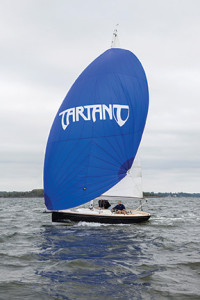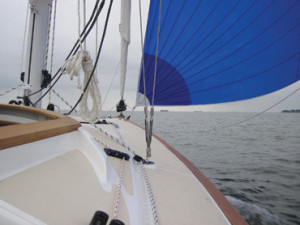We had our first look at the new Tartan Fantail 26 at the Annapolis sailboat show, and we must admit—of all the boats we planned to test after the show, the little 26-footer was one we really looked forward to sailing.
Tartan hasn’t built boats under 30 feet in many years, so this new Tim Jackett design is an interesting development. The company started life in the 60s with the Tartan 27 and later came out with the racing Tartan 26. But since then, the trend has been to build larger, more luxurious cruisers and racer-cruisers.
With the crew from Tartan aboard, we set off from the docks under power. This is a big part of the Fantail story—the boat was conceived to be “green” and is powered by a Torqeedo electric outboard. The engine is mounted inside the lazarette and can kick up out of the water when under sail. Under power in the down position, the little engine pushes the Fantail along at a good clip. Torqeedo engines have a lot of torque, so you feel the acceleration as soon as you push the throttle forward.
 Technically, the Torqeedo is a very interesting propulsion system for a small sailboat. The throttle and gear shifter is linked to a GPS and has a small LED readout that gives you course, speed and remaining powering range. The electric motor is powered by two 4D AGM batteries and a third Group 27 battery is used to power onboard systems such as running lights, reading lights and electronics. With a full charge, the motor will drive the boat at half speed or about 4 knots for 16 hours before the batteries need to be charged again. Tartan provides a shore-power battery charging system and, for those who will keep their boats on moorings, they offer wind and solar charging systems as options.
Technically, the Torqeedo is a very interesting propulsion system for a small sailboat. The throttle and gear shifter is linked to a GPS and has a small LED readout that gives you course, speed and remaining powering range. The electric motor is powered by two 4D AGM batteries and a third Group 27 battery is used to power onboard systems such as running lights, reading lights and electronics. With a full charge, the motor will drive the boat at half speed or about 4 knots for 16 hours before the batteries need to be charged again. Tartan provides a shore-power battery charging system and, for those who will keep their boats on moorings, they offer wind and solar charging systems as options.
Once we motored down Back Creek and into the bay, we hoisted the big mainsail and shut down the Torqeedo and tilted it out of the water. Under mainsail alone, the Fantail slipped along nicely; with the addition of the small, self-tacking jib, the boat really put her shoulder down and started to move.
The late afternoon breeze was fairly light but steady at about 8 knots. This was a perfect wind for the Fantail. Sailing upwind, she tacked at about 40 degrees from the true wind and was able to maintain about 5 knots. Tacking the Fantail involves nothing more than steering the boat through the eye of the wind and settling onto the new angle.
We tacked up the Severn River next to the U.S. Naval Academy and then turned to run back out into the Chesapeake Bay. With the wind behind us, we rolled up the jib, deployed the retractable bowsprit and hoisted a big asymmetrical chute. The response was immediate as the 26-footer took off like a rocket.
 THE DESIGN
THE DESIGN
The design of the Fantail is a pleasing mixture of traditional good looks with a modern fin keel, spade rudder configuration under the water. The keel is fitted with a lead ballast bulb that lowers the boat’s center of gravity and improves stiffness so it will stand up to a blow and sail at low heeling angles.
The boat’s bow is nearly plumb and the sprit is housed in a tube built into the bow on the centerline, not to one side. This complicates the build a bit but is the better way to go and looks just right with the sprit all the way in or out. Control lines for the sprit run under the deck to line clutches in the cockpit.
The boat has a traditional counter and stern that looks handsome and provides the locker space aft of the cockpit to house the Torqeedo. The daysailer and weekender versions of the boat come with handsome teak toe rails, cockpit trim and companionway trim. On the boat we sailed, the teak had been left natural. For those wanting true yacht style, a few coats of varnish on the teak trim would add some flair.
 The cockpit is nine feet long, so four adults can fit comfortably and still manage the sheets and control lines without getting in each other’s way. The self-tacking jib certainly reduces sheet clutter in the cockpit. The main sheet is all the way aft, where it is handy to the helm.
The cockpit is nine feet long, so four adults can fit comfortably and still manage the sheets and control lines without getting in each other’s way. The self-tacking jib certainly reduces sheet clutter in the cockpit. The main sheet is all the way aft, where it is handy to the helm.
The design of the hull and the height of the topsides are configured to allow you to sit in the boat securely instead of being perched on deck and to sit on the bunks below decks without bumping your head. The cockpit seatbacks are contoured to provide support and comfort. Tartan offers cockpit canvas as an option. With a dodger fitted over the companionway, you will feel very secure in the cockpit and will be able to get out of the wind and spray.
 DOWN BELOW
DOWN BELOW
We sailed the daysailer version, which has a low cabin and a small interior. Down below there was a V-berth all the way forward that would be fine for an overnight with sleeping bags—camping style. There is space for a 48-quart, 12-volt cooler, a porta-potty, and gear and equipment. The spinnaker lives in the V-berth when not in use.
The weekender version of the Fantail has a larger cabintop, more headroom below, and a finer level of finish and trim detailing. Plus, it can have a proper marine head with a holding tank and pump-out deck fitting. For weekend cruising, you can add a small galley unit that has an alcohol stove.
With the big chute drawing nicely, we sailed the Fantail right out into the middle of the Chesapeake Bay, making a steady 6 knots and getting over 7 in the puffs. The helm was light to the touch, but because the sail we were using was a tad on the large side, we had to pay attention to avoid rounding up in the stronger puffs, as you would on any small boat with a high aspect spade rudder under a press of sail. By keeping the sailing angle quite low, we were able to get her going as if on rails.
 We have something of a soft spot for smaller Tartan designs since we grew up sailing a Tartan 27—parents and three large sons—all over New England as we cruised to PHRF regattas, raced over weekends and then sailed home again. The new Fantail updates the concept by a country mile. The Fantail 26 is less of a cruising boat than a fine daysailer and weekender, which suits today’s sailing styles. Yet, you could take the weekender off for a week at a time and have a very pleasant small boat cruising experience.
We have something of a soft spot for smaller Tartan designs since we grew up sailing a Tartan 27—parents and three large sons—all over New England as we cruised to PHRF regattas, raced over weekends and then sailed home again. The new Fantail updates the concept by a country mile. The Fantail 26 is less of a cruising boat than a fine daysailer and weekender, which suits today’s sailing styles. Yet, you could take the weekender off for a week at a time and have a very pleasant small boat cruising experience.
By the time we got the Fantail back to the dock, we had enjoyed an excellent sail aboard a sweet little boat that exceeded our expectations. For 2012, the Fantail is one of the finest new boats to come on the scene.
Tartan Fantail 26
LOA 26’0”
LWL 22’2”
Beam 8’5”
Draft 4’6”
Displacement 3,050 lbs.
Ballast 1,200 lbs.
Ballast/Displ .39
Displ/LWL 125.6
Tartan Yachts
www.tartantachts.com
440-392-2628












